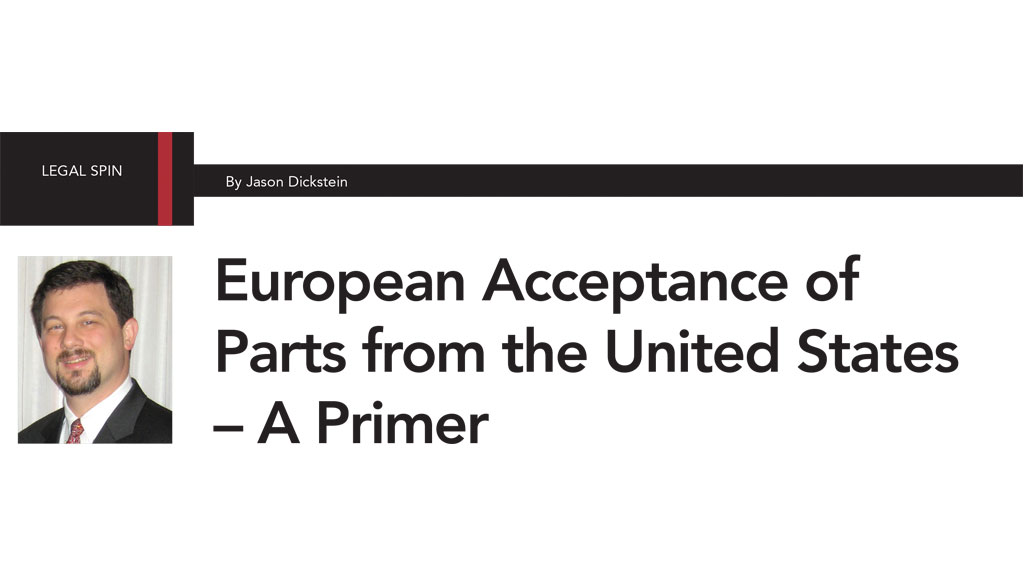Did you know that FAA-PMA parts are approved by EASA? Under the European system, they are not merely accepted – they are actually approved under the terms of a 2007 EASA decision. And that EASA approval happens automatically the moment that they are approved by the issue of the FAA PMA (without the requirement for a separate application).
There are a lot more PMA parts than many people realize. An FAA PMA is the normal approval mechanism for any company that wants to produce and sell civil aircraft parts to the marketplace but that does not possess a production certificate for a complete aircraft, engine or propeller. Major companies like Honeywell produce aircraft parts under PMA; so it is important to ensure that parts produced under this approval mechanism can be accepted in order to ensure that aircraft can keep flying with safe (approved) replacement parts.
The European Union (EU) regulations require that EASA issue certificates for the design of parts and of their installation into products subject to those EU regulations. This created a problem because when EASA was formed, several significant EU member states had long-standing agreements to accept FAA-PMA parts from the United States. This made sense for supporting European air carriers who were already using such parts.
In order to deal with this legally – while at the same time forbearing from unnecessarily inhibiting trade – EASA issued a decision that automatically approves certain FAA-PMA parts. This decision was known as EASA Decision No. 2007/003/C and it can be summarized as follows:
1) The EU needs to approve parts before they can be installed on aircraft, and this approval needs to cover design and installation eligibility
2) Member states have concluded bilateral agreements with the United States for the acceptance of FAA-PMA parts
3) As long as EU-member states continue to have bilateral agreements with the United States for the acceptance of FAA-PMA parts, it is most efficient to approve those parts in advance
4) Therefore, the 2007 decision preemptively approves all FAA-PMA parts that meet at least one out of three criteria
An FAA-PMA part only needs to meet one out of these three criteria to be considered ‘approved’ under the 2007 decision.
The first category of EASA-approved parts is FAA-PMA parts that are not ‘critical components.’ These are considered approved by EASA. No further action is required.
A ‘critical component’ is a part identified as critical by the design approval holder, or otherwise by the exporting authority. The design approval holder for a PMA is the PMA holder, so the PMA holder will be the one to know whether the part is critical. Typically, critical copmponents are identified as such because they have some sort of “hard time” feature described in the Airworthiness Limitations of the instructions for continued airworthiness (ICAs). “Hard times” can include a replacement time, inspection interval, or related procedure that is specified in the Airworthiness Limitations of the manufacturer’s ICAs.
The definition of critical component that is found in the 2007 Decision includes a caveat that the exporting authority (the United States in the case of a FA-PMA made in the US) may also designate something as critical. A mechanism for this arises when an airworthiness directive is issued against the part number, and it imposes some sort of airworthiness limitation.
Most PMA parts do not have these sort of hard times associated with them, so most PMA parts are not critical components. For these parts, EASA requests that the statement “This PMA part is not a critical component” be written in the Remarks Block of the FAA Form 8130-3.
The second category of FAA-PMA parts that are automatically considered to be approved by EASA are those for which the design data comes from a licensing agreement from the holder of the FAA design approval (type certificate or supplemental type certificate). Such parts can be identified in the FAA’s PMA database, because they will indicate that the design approval basis is a licensing agreement.
Some European importers have reached out to us in the past because of concerns about how to accept licensed non-critical parts. Because the first category addresses non-critical parts, this second category is often thought of as being limited to critical parts; however the specific language of the EASA Decision (and of the later EU-US Technical Implementation Procedures that have repeated this language in section 2.8) does not limit this category to critical parts. Therefore, licensed non-critical parts fit into both this category and also into category one. They can be accepted into the EU under either category, at the discretion of the contracting parties.
EASA requests that the statement “Produced under licensing agreement from the FAA design approval holder” be written in in the Remarks Block of the FAA Form 8130-3 for licensed parts.
The third category is for non-licensed critical FAA-PMA parts. These are only automatically approved by EASA if the PMA holder can show that the part has received an explicit approval by means of a design change or STC from EASA. This is normally accomplished when the PMA holder applies for an EASA STC through the local FAA Aircraft Certification Office, and in response EASA issues an STC to validate the PMA design.
EASA will also accept design approvals granted prior to 28 September 2003, from any of the National Aviation Authorities of the Members States of the European Union.
One feature of a FAA-PMA which makes it different from a Technical Standard Order Authorization (TSOA) is that a FAA-PMA has an inherent installation eligibility. On the PMA supplement, there is a designation of one or more types on which the PMA is eligible, and a statement about the part number(s) that the FAA-PMA part replaces. In the United States, this statement support the installers obligation to make a finding of eligibility under 14 CFR 43.13 (the installer’s obligation to ensure that the part will return the product to a condition at least equal to original or properly altered condition).
In Europe, there is a similar obligation for eligibility. The manufacturer certifies eligibility (EASA 21.A.307) and the installer ensures eligibility before installing (EASA 145.A.42(b)). So how does the EU handle PMA eligibility?
Under the 2007 Decision, EASA issued a blanket approval to the PMA part. That approval was not limited, so it is consistent with the scope described in the PMA (design, production and eligibility).
Under the Technical Implementation Procedures (TIP), EASA has gotten more specific in its approach to acceptance of PMA eligibility. The TIP explains that PMA approvals are directly accepted for installation on products “without further showing.”
In addition, EASA has stated that it will accept repair data from the United States on non-critical components when it comes in the form of a PMA (TIP Section 3.3.2.2). The TIP explains that the data is considered to be EASA-approved following its approval/acceptance by the FAA; and the process does not require application to EASA, nor does it require any compliance finding to the EASA certification basis. Where the installation of an FAA-PMA represents a major repair, the FAA data is accepted when it is presented in the form of an 8110-3 (a common form used for the approval of design data underlying a PMA part) or when it is substantiated in an FAA letter (such as the letter granting PMA).

Then please register for the 2016 MARPA Conference,
which will take place October 25-26, 2017 at the B Resort and
Spa in Orlando, Fla.
